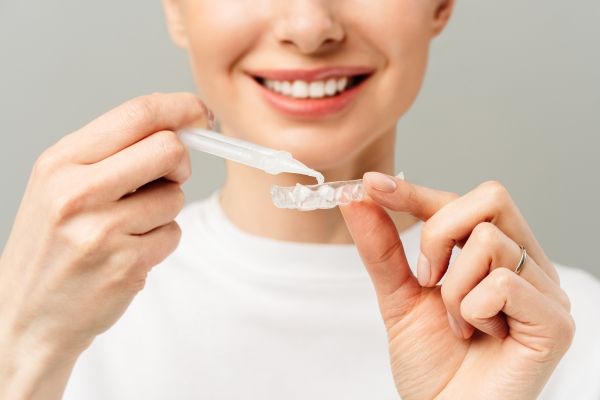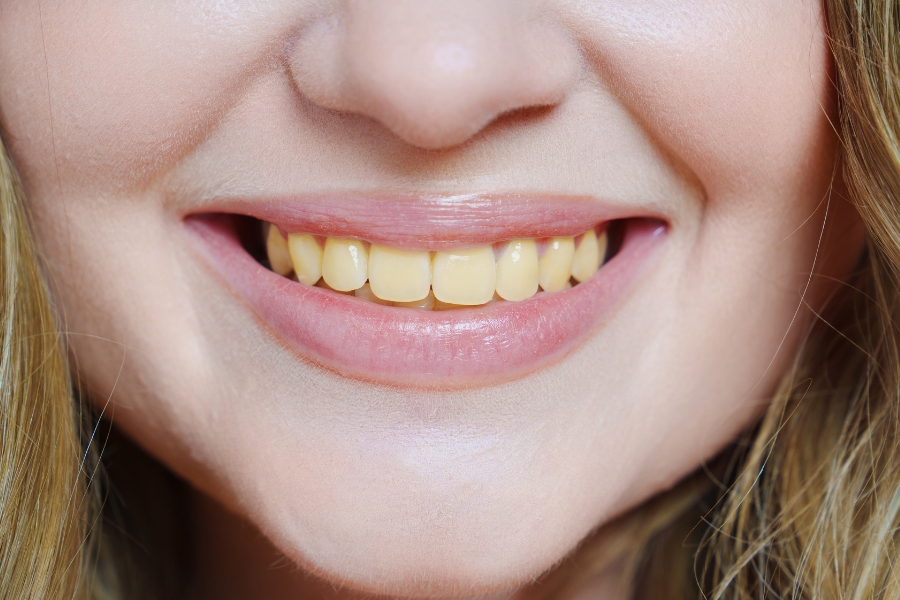You’ve made the switch from smoking to vaping, thinking it’s a healthier option. But now, you’re wondering if vaping could be staining your teeth and affecting your bright smile. It’s a valid concern! Your smile is one of the first things people notice about you, and keeping it white and sparkling is important for your confidence. Let’s discuss whether vaping can stain your teeth, how it happens, and what you can do about it. Plus, we’ll dive into how teeth whitening works to help you achieve a brighter smile.
Can Vaping Really Stain Your Teeth?
You might think that vaping, being free of the tar and many of the chemicals found in cigarettes, would be kinder to your teeth. However, according to Healthline, it’s not entirely harmless when it comes to your dental health. Let’s get into the nitty-gritty of how vaping can affect your teeth.
The Impact of E-Liquids on Your Teeth
E-liquids, the substance you vape, often contain nicotine, flavorings, and other chemicals. Nicotine itself doesn’t directly stain teeth, but it can contribute to plaque buildup, which can eventually lead to discoloration. The flavorings and colorings in e-liquids can also be culprits. If you’re vaping a lot of e-liquid that’s colored or has certain artificial flavorings, it can stick to your teeth and cause staining over time.
How Does Vaping Lead to Teeth Staining
Understanding the science behind how vaping leads to staining can help you take steps to prevent it. Let’s break it down further.
Does Nicotine Cause Staining?

Even though nicotine isn’t as directly staining as tar, it does have an indirect role. When nicotine mixes with oxygen, it turns yellow, and this yellowing can adhere to your teeth. This means that while the effects might be slower and less obvious than with smoking, they’re still there, creeping up on your pearly whites.
Chemical Interactions in Your Mouth
The chemicals in vaping liquids can react with the bacteria in your mouth, leading to a series of chemical reactions that can discolor your teeth. These reactions can create a sticky film on your teeth, trapping pigments and causing stains. Over time, these stains become more noticeable, dulling your smile.
Heat Exposure: Leading to Teeth Cracking
Repeated exposure to heat from vaping can cause tiny cracks and fissures in your enamel. These cracks are like little highways for stains, allowing pigments from your food, drinks, and the vaping liquids themselves to penetrate deeper into your teeth. This makes stains harder to remove with regular brushing alone.
Dry Mouth: Main Cause of Staining
As mentioned, dry mouth is a common side effect of vaping. Saliva is essential for breaking down food particles and preventing the buildup of plaque and bacteria. Without enough saliva, your mouth becomes a breeding ground for bacteria, which can lead to more plaque and more staining. Dry mouth can also make your mouth feel uncomfortable and can contribute to bad breath, compounding the negative effects of vaping on your oral health.
Now that we’ve covered how vaping can stain your teeth, let’s look at how you can get that bright smile back. Teeth whitening is a popular solution, and there are several methods available, from at-home treatments to professional whitening.
Different Teeth Whitening Methods To Choose From
When it comes to teeth whitening, there are a variety of methods to choose from, each with its own set of pros and cons. Knowing the differences between these methods can help you make the best choice for your needs and lifestyle. Let’s dive into the main types of teeth whitening treatments available.
In-Office Professional Whitening

Here’s how it works:
- Preparation: Your dentist will start by cleaning your teeth to remove any plaque or debris. This ensures that the whitening agent can penetrate your teeth more effectively.
- Protection: They’ll then apply a protective gel or rubber shield to your gums to protect them from the whitening agent, which is usually a high-concentration hydrogen peroxide or carbamide peroxide.
- Application: The whitening agent is applied to your teeth, and sometimes a special light or laser is used to enhance the effect. This process usually takes about an hour, and you may need more than one session for optimal results.
- Results: The results are immediate, and your teeth can become several shades whiter after just one visit.
Pros: Quick and effective, professional supervision ensures safety and minimizes risks of sensitivity or gum irritation.
Cons: More expensive than at-home treatments, requiring a visit to the dentist’s office.
At-Home Teeth Whitening Kits

At-home teeth whitening kits provide a more convenient and affordable option for many people. These kits typically include custom-fit trays and a lower concentration of whitening gel than what’s used in the dentist’s office. Here’s what the process looks like:
- Custom Trays: You make a mold of your teeth at home, which is used to create custom-fit trays that you’ll wear during the treatment.
- Gel Application: The trays are filled with the whitening gel and worn for a specified amount of time each day, usually between 30 minutes to a few hours.
- Treatment Duration: The entire process takes several weeks, with gradual whitening results.
Pros: More affordable than professional whitening, can be done at your convenience at home, and custom trays ensure better contact with teeth.
Cons: Takes longer to see results, and the lower concentration of whitening agent might be less effective for severe stains.
Over-the-Counter Whitening Products
For those looking for a quick and easy way to brighten their smile, over-the-counter whitening products can be a good option. These include whitening strips, toothpaste, and mouthwashes. Here’s how they work:
- Whitening Strips: These thin, flexible strips are coated with a peroxide-based whitening gel. You apply the strips directly to your teeth and leave them on for a set period, usually 30 minutes.
- Whitening Toothpaste and Mouthwash: These products contain mild abrasives and small amounts of peroxide to help remove surface stains with regular use.
- Results: These products can help maintain a bright smile and are good for addressing minor surface stains, but they’re generally less effective than custom trays or professional treatments
Pros: Easy to use, widely available, and inexpensive.
Cons: Less effective for deep stains, results can be slow and may not be as dramatic.
Potential Side Effects of Teeth Whitening You May Experience
While teeth whitening is generally safe, it’s important to be aware of potential side effects. Knowing what to expect can help you manage any discomfort and make informed decisions about your whitening treatments.
Increased Tooth Sensitivity
One of the most common side effects of teeth whitening is increased tooth sensitivity. This happens because the whitening agents can penetrate the enamel and irritate the nerves inside your teeth. Sensitivity is usually temporary and can be managed with desensitizing toothpaste or by reducing the frequency of your whitening treatments.
Expect Some Gum Irritation
Gum irritation can occur if the whitening gel comes into contact with your gums. This is more likely to happen with over-the-counter products that aren’t custom-fitted to your teeth. To avoid this, be careful when applying the gel and consider using a product with a lower concentration of whitening agent.
Increased Chance of Enamel Damage
Excessive or improper use of whitening products can lead to enamel damage, making your teeth more susceptible to decay and other issues. It’s important to follow the instructions carefully and not to overuse whitening products. If you have concerns about your enamel, consult your dentist before starting a whitening treatment.
Uneven Teeth Whitening
If you have dental restorations like crowns or veneers, they won’t whiten the same way your natural teeth do. This can lead to uneven whitening and noticeable differences in color. Your dentist can help you pla
Natural Teeth Whitening Tips

We realize that there’s quite a few people who’d prefer some natural teeth whitening methods too. So we’re gonna list some of the methods that Healthline has highlighted, these will definitely show results with consistent use.
- Baking Soda: Brushing with baking soda can gently scrub away surface stains.
- Hydrogen Peroxide: Diluted hydrogen peroxide can be used as a mouthwash to whiten teeth.
- Oil Pulling: Swishing coconut oil in your mouth may help remove plaque and whiten teeth.
- Fruits: Strawberries and pineapple contain enzymes that can help whiten teeth naturally.
How You Can Maintain Your Smile After Teeth Whitening Treatment
Once you’ve achieved your desired level of whiteness, you’ll want to maintain your bright smile for as long as possible. Here are some tips to help you keep your teeth looking their best.
- Brush and Floss Regularly: Brush your teeth twice daily with fluoride toothpaste and floss daily to reduce plaque and bacteria buildup.
- Watch Your Diet: Limit staining foods and drinks like coffee, tea, red wine, and dark sodas. Rinse with water after consuming them or use a straw to minimize contact with your teeth.
- Quit Vaping and Smoking: Both can cause tooth staining. Consider quitting to maintain a whiter smile and improve overall oral health.
- Use Whitening Toothpaste: Incorporate a whitening toothpaste with mild abrasives and peroxide to prevent surface stains from setting in.
- Schedule Touch-Up Treatments: Periodically use at-home whitening kits or professional treatments to maintain your smile’s brightness.
- Stay Hydrated: Drink plenty of water throughout the day to keep your mouth clean and reduce the risk of staining.
- Regular Dental Visits: Visit your dentist for checkups and cleanings to monitor your oral health and keep your smile radiant.
Final Thoughts
By following these tips and being mindful of your habits, you can enjoy a bright, white smile for years to come. Remember, while teeth whitening can give you a quick boost in confidence, maintaining those results requires a commitment to good oral hygiene and healthy lifestyle choices. If you have any concerns about teeth whitening or maintaining your results, don’t hesitate to talk to your dentist. They can provide personalized advice and recommendations to help you achieve and maintain the smile of your dreams.
FAQs
1. Does vaping stain your teeth worse than smoking?
Both vaping and smoking can contribute to tooth staining, but vaping generally causes less severe stains compared to smoking traditional cigarettes.
2. Can whitening toothpaste remove deep stains?
Whitening toothpaste can help with surface stains, but for deeper stains, professional whitening treatments may be more effective.
3. Are there any side effects of teeth whitening?
Temporary tooth sensitivity and gum irritation are common side effects of teeth whitening treatments, but they usually resolve after treatment.
4. How often should I visit the dentist for teeth whitening?
The frequency of teeth whitening visits depends on your oral health and the whitening method used. Consult your dentist for personalized recommendations.
